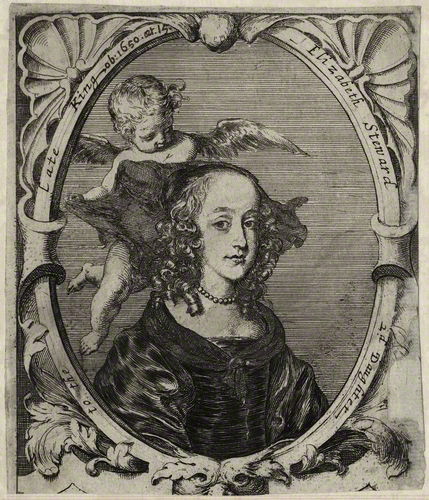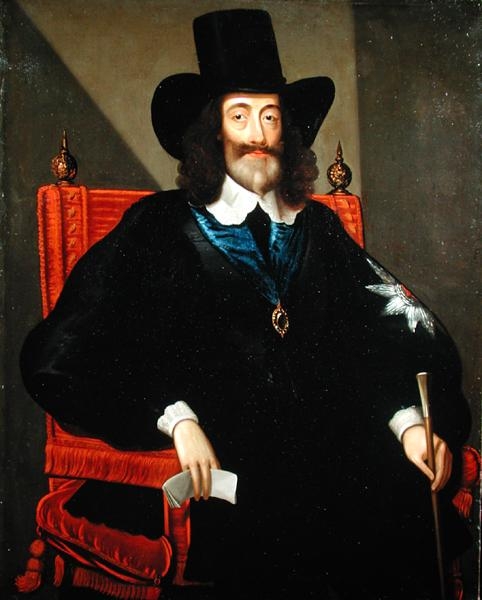by Susan Flantzer
© Unofficial Royalty 2023

Princess Elizabeth; Credit – Wikipedia
Princess Elizabeth of England, also known as Elizabeth Stuart, was born on December 28, 1635, at St. James’s Palace in London, England. She was the fifth of the nine children and the second of the five daughters of King Charles I of England and Henrietta Maria of France. Elizabeth’s paternal grandparents were King James I of England and Anne of Denmark. Her maternal grandparents were King Henri IV of France and his second wife Marie de’ Medici.

King Charles I’s five eldest surviving children in 1637: Left to right: Mary, James, Charles, Elizabeth, and Anne; Credit – Wikipedia
Elizabeth had eight siblings:
- Prince Charles James of England, Duke of Cornwall and Rothesay, born and died May 13, 1629
- King Charles II of England (1630 – 1685), married Catherine of Braganza, no children, but Charles II had at least 14 illegitimate children
- Mary, Princess Royal (1631 – 1660), married Willem II, Prince of Orange, had one child: Willem III, Prince of Orange, later King William III of England
- King James II of England (1633 – 1701), married (1) Anne Hyde, had eight children, but only two survived childhood, both reigning Queens: Queen Mary II of England and Queen Anne of England (2) Maria Beatrice of Modena, had seven children but only two survived childhood including James Francis Edward Stuart, The Old Pretender
- Princess Anne of England (1637 – 1640) died young from tuberculosis
- Princess Catherine of England, born and died June 29, 1639
- Prince Henry of England, Duke of Gloucester (1640 – 1660) unmarried, died from smallpox
- Princess Henrietta of England (1644 – 1670), married Philippe, Duke of Orléans, had three children
Elizabeth was well connected to European royalty through her maternal aunts and uncles: King Louis XIII of France; Elisabeth, Queen of Spain, wife of King Felipe IV of Spain, Christine Marie, Duchess of Savoy, wife of Vittorio Amedeo I, Duke of Savoy; and Gaston, Duke of Orléans. Her only surviving paternal aunt or uncle was Elizabeth Stuart who had married Friedrich V, Elector Palatine. Through Elizabeth and Friedrich’s daughter Sophia the Protestant Hanovers came to the British throne in 1714 via the 1701 Act of Settlement.
Elizabeth’s father King Charles I had issues with Parliament, clashing with its members over financial, political, and religious issues. These issues eventually caused the English Civil War (1642 – 1651). During the English Civil War, of Elizabeth’s surviving siblings, her sister Mary was married and living in the Dutch Republic, her eldest brother Charles was in the Dutch Republic with their sister Mary or in France where their mother Queen Henrietta Maria and her sister Henrietta were living in exile, and where their young first cousin King Louis XIV sat upon the throne of France. Elizabeth’s brother James, the second son, remained in Oxford, England, the royalist stronghold, while his father King Charles I fought against the forces of the Parliamentarians, also known as the Roundheads.

(Left to Right) Prince Henry, Duke of Gloucester, Princess Elizabeth and Prince James, Duke of York, the future King James II, by Sir Peter Lely, 1647; Credit – Wikipedia
Elizabeth and her younger brother Henry were unable to flee with their mother because they were not with her at that time. They remained in England and were placed under the care of the Parliamentarians. For several years, Elizabeth and Henry were moved from one residence to another due to the plague. They also had their governesses and guardians periodically changed. When the city of Oxford surrendered in 1646, Elizabeth and Henry’s elder brother James was arrested and placed with them in St. James’ Palace. In 1647, their father Charles I was arrested, and during the years 1647 – 1648, he was allowed to see his three children who were in England several times. In 1648, James managed to escape and fled to the Dutch Republic, where his sister Mary lived. James had wanted to take Henry with him but Elizabeth was afraid to let her younger brother go.

Elizabeth’s father King Charles I at his trial by Edward Bower, 1649; Credit – Wikipedia
On January 20, 1649, Charles I’s trial at Westminster Hall in London, England began. He was accused of treason against England by using his power to pursue his personal interest rather than the good of England. He was declared guilty and sentenced to death on January 27, 1649. On January 29, 1649, the day before his execution, Charles was allowed to see 13-year-old Elizabeth and 8-year-old Henry at St. James’s Palace in London where he was being held. He told Elizabeth to be faithful to the “true Protestant religion” and to tell her mother that “his thoughts had never strayed from her.” He warned Henry to “not be made a king” by the Parliamentarians because he suspected they would make the boy a puppet king. Charles divided his jewels among the two children, keeping only his George, an enameled figure of St. George, worn as a part of the ceremonial dress of the Order of the Garter. He gave Elizabeth his Bible.

A 19th-century depiction of Elizabeth and Henry at Carisbooke Castle by Margaret Dicksee, circa 1895; Credit – Wikipedia
After the execution of their father, Elizabeth and Henry became unwanted charges. Parliament refused to allow them to go to the Dutch Republic. Robert Sidney, 2nd Earl of Leicester and his wife Dorothy agreed to take charge of Elizabeth and Henry at their home, Penshurst Place in Penhurst, Kent, England, 32 miles/51 km from London. However, in 1650, when Elizabeth and Henry’s eldest brother, now the titular King Charles II, traveled to Scotland to be crowned King of Scots, Parliament decided Elizabeth and Henry needed to be in a more secure place, far away from London. Elizabeth and Henry were moved to Carisbrooke Castle on the Isle of Wight, England. The number of their servants was reduced to four people. Elizabeth and Henry were deprived of their prince and princess titles and Henry was additionally deprived of his Duke of Gloucester title.
On August 23, 1650, less than a week after arriving at Carisbrooke Castle, Elizabeth began to feel ill. On September 1, she went to bed and soon she could no longer get up. She died on September 8, 1650, aged fourteen, probably from pneumonia. Reportedly, Elizabeth was found dead with her head on her father’s Bible. She was buried in a small crypt under the altar at Saints Thomas Church in Newport, on the Isle of Wight.

Memorial to Princess Elizabeth, erected over her grave by Queen Victoria; Credit – Wikipedia
There was no marker on Elizabeth’s grave. Eventually, travelers to the Isle of Wight began to discover Elizabeth’s burial place from the initials ES – for Elizabeth Stuart – carved on the nearest wall. In 1856, Queen Victoria ordered a white marble monument designed and made by Carlo Marochetti, an Italian-born French sculptor, to be installed over Elizabeth’s grave. The effigy shows Elizabeth with her head resting on an open Bible. The Bible is opened to Matthew 11:28: “Come to me, all you who are weary and heavy laden, and I will give you rest.” The inscription on the memorial says: “In memory of Princess Elizabeth, daughter of King Charles I, who died at Carisbrooke Castle on September 8, 1650, and was buried under the altar of this church. This monument erected in respect to her virtue and sympathy for her hardships by Queen Victoria, 1856″.

Elizabeth’s effigy; Credit – www.findagrave.com
This article is the intellectual property of Unofficial Royalty and is NOT TO BE COPIED, EDITED, OR POSTED IN ANY FORM ON ANOTHER WEBSITE under any circumstances. It is permissible to use a link that directs to Unofficial Royalty.
Works Cited
- Elizabeth Stuart (1635-1650) – Find a Grave… (no date) Find a Grave. Available at: https://www.findagrave.com/memorial/17950850/elizabeth-stuart (Accessed: February 12, 2023).
- Elizabeth Stuart (daughter of Charles I) (2023) Wikipedia. Wikimedia Foundation. Available at: https://en.wikipedia.org/wiki/Elizabeth_Stuart_(daughter_of_Charles_I) (Accessed: February 12, 2023).
- Елизавета Стюарт (дочь карла I) (Elizabeth Stuart) (2022) Wikipedia (Russian). Wikimedia Foundation. Available at: https://ru.wikipedia.org/wiki/%D0%95%D0%BB%D0%B8%D0%B7%D0%B0%D0%B2%D0%B5%D1%82%D0%B0_%D0%A1%D1%82%D1%8E%D0%B0%D1%80%D1%82_(%D0%B4%D0%BE%D1%87%D1%8C_%D0%9A%D0%B0%D1%80%D0%BB%D0%B0_I) (Accessed: February 12, 2023).
- Flantzer, Susan. (2020) Execution of Charles I, King of England (1649), Unofficial Royalty. Available at: https://www.unofficialroyalty.com/execution-of-charles-i-king-of-england-1649/ (Accessed: February 12, 2023).
- Flantzer, Susan. (2016) Henrietta Maria of France, Queen of England, Unofficial Royalty. Available at: https://www.unofficialroyalty.com/henrietta-maria-of-france-queen-of-england/ (Accessed: February 12, 2023).
- Flantzer, Susan. (2016) King Charles I of England, Unofficial Royalty. Available at: https://www.unofficialroyalty.com/king-charles-i-of-england (Accessed: February 12, 2023).
- Henry Stuart, Duke of Gloucester (2023) Wikipedia. Wikimedia Foundation. Available at: https://en.wikipedia.org/wiki/Henry_Stuart,_Duke_of_Gloucester (Accessed: February 12, 2023).
- Weir, Alison. (1989) Britain’s Royal Families: The Complete Genealogy. London: Vintage Books.
- Williamson, David. (1996) Brewer’s British Royalty: A Phrase and Fable Dictionary. London: Cassell.
